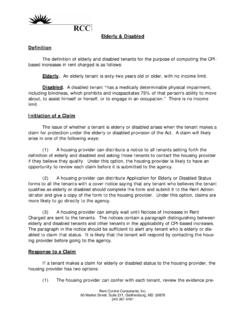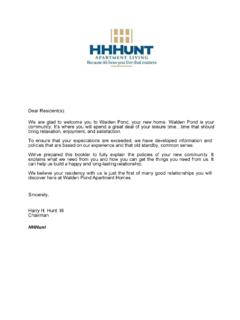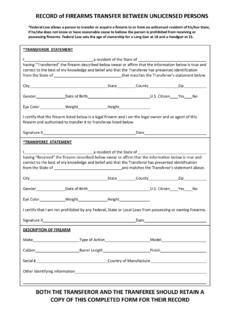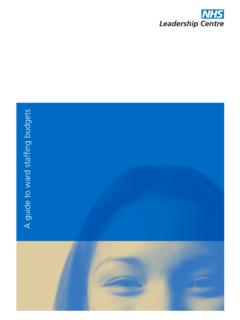Transcription of What You Should Know About Rent Control in the …
1 what You Should know About Rent Control in the District of Columbia rev. February 2014 Page 1 of 7 Department of Housing and Community Development | 1800 Martin Luther King Jr. Avenue, SE Washington, DC 20020 | (202)442-7200 This pamphlet will help you understand rent Control laws and regulations. The rent Control law is the Rental Housing Act of 1985 (DC Law 6-10) as amended (the Act), which is codified as DC Official Code et seq., as well as the corresponding Municipal Regulations, Title 14, Chapter 4200 et seq. You can find the complete law in most DC public libraries or online at: Rental Accommodations Division The Rental Accommodations Division (RAD), which is part of the Department of Housing and Community Development s (DHCD) Housing Regulation Administration (HRA), is responsible for administering the Act. The head of RAD is the Rent Administrator. HRA was transferred from the Department of Consumer and Regulatory Affairs to DHCD, effective October 1, 2007.
2 Office of Administrative Hearings The Office of Administrative Hearings (OAH) conducts hearings on RAD petitions. Rental Housing Commission A separate, 3-member Rental Housing Commission (RHC) is the first level of appeal of the decisions made on RAD petitions. The RHC also writes regulations under the Act. Rent Control Terms Under the Act, an apartment building or apartment complex is called a housing accommodation, and a single apartment or house is called a rental unit. A tenant is a tenant, but a landlord is referred to as a housing provider. Applicability The Act applies to all housing accommodations in the District of Columbia, unless they are specifically exempted by the Act. The most common exemptions are rental units in these categories: Federally or District-subsidized rental units, Rental units built after 1975, Rental units (including condominium or cooperative units) owned by a natural person who owns no more than four rental units, provided the rental units are registered as exempt, Rental units that were vacant when the Act took effect, and Housing accommodations under a building improvement plan and receiving rehabilitation assistance through DCHD.
3 Registration Every housing accommodation or rental unit must be registered with RAD by filing a RAD Registration and Claim of Exemption form. Once registered, the housing accommodation or rental unit is assigned a registration number if it is subject to rent Control . If it is exempt, it is assigned an exemption number. If a housing accommodation was initially exempt from the Act but later becomes subject to the Act, the housing provider must amend the RAD Registration and Claim of Exemption form at that time. Changes in ownership or management must be filed with RAD within 30 days of the event. Increases in Rent Under the Act, any increase in rent must meet these conditions: 1. The new rent charged may not be more than the prior rent plus an allowable increase, as described below. 2. The increase in rent charged cannot be more than the increase allowed under any single section of the Act. 3. The last increase in rent must have been at least 12 months ago (unless the unit is vacant).
4 what You Should know About Rent Control in the District of Columbia what You Should know About Rent Control in the District of Columbia rev. February 2014 Page 2 of 7 Department of Housing and Community Development | 1800 Martin Luther King Jr. Avenue, SE Washington, DC 20020 | (202)442-7200 4. The increase must not violate the terms of the lease. 5. The housing accommodation must be properly registered with the RAD. 6. The rental unit and the housing accommodation s common elements must be in substantial compliance with housing regulations. 7. The housing provider must give a 30-day notice of any increase in rent. Allowable Rent Increases Based on CPI-W The most common allowable increase in rent is an annual adjustment, based on the increase in the Consumer Price Index (CPI-W). For most tenants, the most that their rent can increase is the CPI-W percentage plus 2%, but not more than 10%. For tenants who are elderly or disabled, the maximum increase in rent charged is the CPI percentage only, but not more than 5%.
5 Allowable increases based on CPI are sometimes called automatic -- because no petition or other special steps are required. Rent Increases When a Unit Becomes Vacant or Vacancy Increase The only exception to the limit of one rent increase per year is when a rental unit becomes vacant. The housing provider can raise the rent charged upon a vacancy to: 10% more than was charged to the former tenant, or Rent for a comparable rental unit, but not more than 30%. Comparable rental units have essentially the same square footage and floor plan; comparable amenities and equipment; comparable locations with respect to exposure and height (if exposure and height have previously been factors in the amount of rent charged) and comparable physical condition. Once there has been a vacancy increase in rent, the housing provider cannot make another increase in rent for 12 months, even if another vacancy occurs. Other Allowable Rent Increases A housing provider may choose to seek larger allowable increases under other provisions of the Act, including hardship, capital improvements, services and facilities or substantial rehabilitation, or agreement with 70% of the tenants.
6 The other allowable increases, described in more detail below, are not automatic. The housing provider must petition or otherwise seek the consent of the Rent Administrator, and tenants may choose to participate in the process, often at hearings before an administrative hearing judge. Hardship Under the Act, housing providers are allowed to raise rents enough to earn a 12% rate of return on the housing provider s rental property investment. To apply for this increase, the housing provider must document operating expenses for 12 of the last 15 months preceding the filing of the hardship petition. RAD will notify the tenants that a hardship petition has been filed and allow the tenants to designate a representative to support or oppose it. RAD performs an audit of the hardship petition and supporting documents. The Rent Administrator issues an order granting or denying the hardship petition. The housing provider and tenants may each submit exceptions and objections to the Rent Administrator s order.
7 If exceptions and objections are submitted, a hearing will be held with OAH to resolve the disputed matters. OAH then issues an order setting the rent increase. Capital Improvements A housing provider can petition to raise rents by an amount enough to cover the cost of capital improvements. A capital improvement is an improvement or renovation other than ordinary repair, repair or maintenance if the improvement or renovation is deemed depreciable under the Internal Revenue Code. A housing provider files a petition, serves copies to the tenants, and presents the case to the Office of Administrative Hearings (OAH). The capital improvement petition must what You Should know About Rent Control in the District of Columbia rev. February 2014 Page 3 of 7 Department of Housing and Community Development | 1800 Martin Luther King Jr. Avenue, SE Washington, DC 20020 | (202)442-7200 be filed no later than 10 calendar days after the installation of the capital improvements.
8 Tenants may support or oppose the petition. If OAH approves the surcharge, the housing provider performs the work and may then raise rents. OAH makes a ruling on the petition, based on: Whether the improvement will protect or enhance the health, safety and security of the tenants or the habitability of the housing accommodation; Whether the improvement will be depreciable under the Internal Revenue Code; Whether required governmental permits and approvals have been secured; and Whether the design and cost of the work are sufficiently documented. In addition to the work s cost, the housing provider can include financing costs, including interest and service charges. The housing provider must spread the costs of a building-wide improvement project for 96 months. For an improvement to one or more but not all rental units, the costs must be spread over for 64 months. Only units affected by the capital improvements are subject to rent increases.
9 The surcharge may be no more than 20% of the prior rent charged for a building-wide capital improvement and no more than 15% for an improvement that does not affect all rental units. The Act allows a housing provider to continue the surcharge until the housing provider has recovered all costs, including interest and service charges, of the capital improvement. Certain low-income elderly and disabled tenants can be exempted from a capital improvement surcharge. The increase is terminated once the housing provider recovers all costs of the capital improvements. This type of increase in rent is called a surcharge. Services & Facilities The Act allows an adjustment in rents when related services or facilities supplied by a housing provider or a housing accommodation or for any rental unit in the housing accommodation are increased or decreased. A housing provider files a petition, serves copies to the tenants, and presents the case for the change at an OAH hearing.
10 Tenants may support or oppose the petition. The OAH makes a ruling on the petition, based on: The cost to the tenant of buying alternate related services or facilities comparable; The operating cost to the housing provider of the related services or facilities; or The fair market value of comparable related services or facilities. Substantial Rehabilitation The housing provider may submit a petition to raise rents for a substantial rehabilitation of the housing accommodation. A substantial rehabilitation petition is filed only when proposed rehabilitation cost equals or is more than 50% of the real property tax assessment of the rental unit or housing accommodation. The petition must include detailed plans, specifications and projected costs. The tenants are notified, a hearing is conducted, and the OAH issues a decision before the work starts. The maximum allowed rent increase is 125%. This rent increase is not a temporary surcharge, but a permanent increase.







